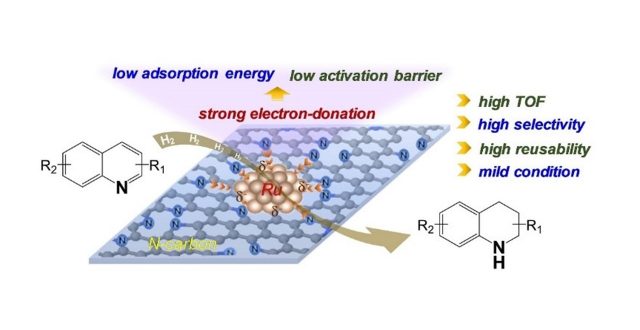Active metal catalysts are the key in chemical industry for sustainable production of multitude of chemical resources. Here, we report a new ruthenium (Ru) composite with a synergistically controlled nanostructure and electronic properties as a highly efficient hydrogenation catalyst which comprises stable small Ru nanoparticles (mean particle size, ca. 0.9 nm) in situ generated into a nanoporous N-functionalized carbon with high surface area (ca. 650 m2 g–1) and has strong electron-donating power of Ru sites of nanoparticles. The scalable and highly reusable catalyst, prepared from a self-assembled Ru complex, performs actively with low per metal usage under mild conditions (60–80 °C and 0.5–1.0 MPa H2) for selective hydrogenation of various quinolines and pyridines. The role of electron-donating properties of the new Ru nanohybrid for highly efficient catalysis was characterized by both experiments and computational studies. Density functional theory calculations reveal that weak adsorption energies of quinoline at the electron-rich Ru surface prevents poisoning caused by its strong coordination and provides excellent reusability of the catalyst, while low activation barriers for the hydrogenation steps of the N-heterocyclic ring correlate with high catalytic activity. Our catalyst exhibits 5–24-fold higher turnover frequency up to ca. 167 h–1 among the efficient noble metal catalysts reported for selective hydrogenation of quinoline to 1,2,3,4-tetrahydroquinoline.

【論文】ルテニウム-窒素含有炭素複合触媒での電子的効果とヘテロアレン水素化能
WRHIからのお知らせ おすすめ
化学資源持続生産研究ユニット 原亨和教授とDebraj Chandra特任准教授の国際共著論文
“Electronic effect in a ruthenium catalyst designed in nanoporous N-functionalized carbon for efficient hydrogenation of heteroarenes”
が、ACS Applied Materials & Interfaces にオンライン掲載されました。
(DOI: 10.1021/acsami.0c15407 )
詳しくはこちら
<Abstract>
